Bighorn Sheep On Bright Angel Trail in the Grand Canyon
Bob and I were well on our way back up to the South Rim from Plateau Point at Grand Canyon National Park after a grueling 12-hours of hiking, so with our noses to the grindstone, we just focused on putting one foot in front of the other to make headway. That is why neither one of us saw the Bighorn Sheep surveying its surroundings from a ledge above the trail, just below Mile-and-a Half Resthouse. If not for other hikers mentioning sight of the animal, we would have completed our hike in total ignorance of its presence.
It had been a long haul on Bright Angel Trail from Plateau Point, scaling the steep slopes back up the canyon wall, and for the duration of the afternoon, Bob and I had been hiking in full sunshine. Our trek had begun at 5 a.m., and we were nearing the end of our energy stores.
We had actually reached the rest stop and were taking advantage of the fresh water supply when we heard animated conversation between other hikers who had seen a Bighorn Sheep just below us on the trail. Bob and I were stupefied. How could we have walked right past it and not noticed? Our exhaustion and intense focus was the only explanation for disregarding our surroundings.
I could not bring myself to hike even a short distance back down the trail as I had barely enough energy left to carry me to the top of the canyon. It was all I could do to put one step in front of the other in order to keep moving forward. So, Bob retraced his steps down the dirt path while I rested and refreshed myself. It was one photographic opportunity that he did not want to miss.
As Bob descended the switchbacks, he feared that the sheep might have moved off, but there it lay in full view some ten feet above the trail in a protected alcove shaded from the sun. Such a cliff habitat is useful as it provides protection from predation and enables a sheep to avoid competition from other herbivores, but at the same time, such steep, rugged terrain also means that Bighorn Sheep often fall to their deaths.
This male Bighorn Sheep, a ram, has an impressive pair of ridged, brown horns that curl back over the ears then down and up again towards the cheeks. By the time a ram is 7 or 8 years of age, his horns will achieve a full curl with a width of 30 inches and a weight of near 30 pounds (14 kg). Older rams will often have curling horns that are at least 3 feet long with a circumference at the base of the horn of over one foot. It is the large curved horns of the rams that inspired the name for this species of animal.
Desert Bighorn Sheep are a subspecies of the Rocky Mountain Bighorn Sheep, but both of these species are descendants of the wild sheep found in Central Asia. Their ancestors crossed to North America using the Bering Land Bridge from Mongolia and Tibet before the last ice age. Desert Bighorn Sheep are found in the deserts of Southwest United States as well as the northern areas of Mexico.
Desert Bighorn Sheep share the same characteristics and behave similarly to other species of Bighorn Sheep, but they have adapted in a unique way. They are able to survive for extended periods of time without drinking water, which is why they are able to subsist in a mountainous desert environment where there is next to no permanent water. Moisture is acquired through food sources or small pockets of rain water.
Desert Bighorn Sheep at one time numbered in the tens of thousands, a small fraction of the overall North American population which was estimated to have been between 1.5-2.0 million. Many factors are responsible for their downturn in numbers – hunting, loss of habitat, confiscation of watering areas for human use, competition with livestock, wild horses and feral burros, and diseases from domestic stock. They have little resistance to infections carried by European sheep and cattle, and, in particular, pneumonia poses a huge threat to the species.
By the 1930s, Frederick Russell Burnham established that there were fewer than 150 Desert Bighorn Sheep still living in the Arizona mountains. In 1936, he initiated a massive campaign through Arizona Boy Scouts to save the majestic animals from extinction. He was a forward thinker and thought that future generations of domestic sheep might possibly be saved from disaster by some as yet unknown virus by providing them with a strain from the wild sheep.
Other well known groups, National Wildlife Federation, Izaak Walton League and National Audubon Society, joined forces, and together, the conservation effort saw the establishment of two wildlife refuges for Bighorn Sheep: Kofa National Wildlife Refuge and Cabeza Prieta National Wildlife Refuge. Today, it is believed that between 18,965 – 19,040 Desert Bighorn Sheep live in well-established herds on about 4% of their original ranges.
As Bob observed this beautiful ram, he became quite disconcerted when the sheep began to retch and then throw up. Was the ram in distress? Was it diseased? Or was it just regurgitating partially digested food? Desert Bighorn Sheep are ruminants, which means that they can extract the maximum amount of nutrition and moisture from the foods they eat by chewing a cud of regurgitated food.
Within minutes, the sheep got to its feet and began to eat leaves from a nearby bush. As part of their diet, Bighorn Sheep browse on shrubs, graze on grasses and will even eat cacti. Ewes have horns, too, though smaller, shorter and lighter than those of rams, so both genders are able to use their horns as tools to break open cacti. Most often ewes forage while they walk as it serves to avoid predators and keep lambs safe. Rams, on the other hand, usually eat then rest and ruminate. This self-serving lifestyle leads to more effective digestion and larger body size.
Bob was amazed at the nimbleness of the ram there on the sloping ledge. Even as the scree slid out from under its feet, the sheep remained solid in its position.
As the ram grazed on the shrub, Bob took notice of its short, stocky, muscular body. The sheep’s short legs give the animal a low centre of gravity, and when required, it can bounce over crevices as wide as 20 feet (6 m).
This ram must be fairly young judging by the size of its horns. The horizontal ridges are the result of the annual growth rings which actually indicate the animal’s age. Because ram’s horns curve outwards and upwards, over time they can interfere with the sheep’s vision. This ram was certainly keeping a keen eye on Bob.
Bob couldn’t help but notice the rich, glossy brown colour of the ram’s coat and the white rump patches. The colouring helped the sheep to blend in well with the surrounding desert environment…a real aid to camouflage from predators such as mountain lions, coyotes, bobcats and even golden eagles. Maybe that is why we walked right past the sheep without seeing it ourselves.
As the Desert Bighorn Sheep moved about the ledge, Bob became concerned that it might descend onto the path where he was standing. Weighing between 127-316 lb (58-143 kg), and standing somewhere between 36-41 inches (91-100 cms) tall at the shoulder, the ram could easily edge Bob off the trail. He did not stick around to find out. Besides, we still had 1 1/2 miles to climb up to the top of the South Rim. We had to get on our way.
Frame To Frame – Bob and Jean

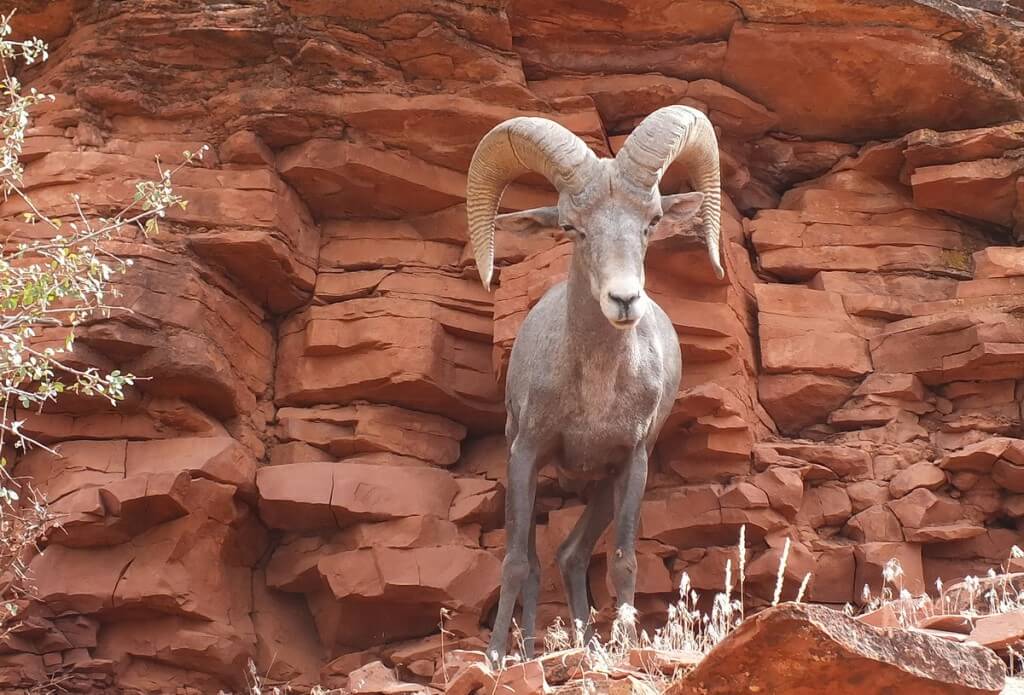
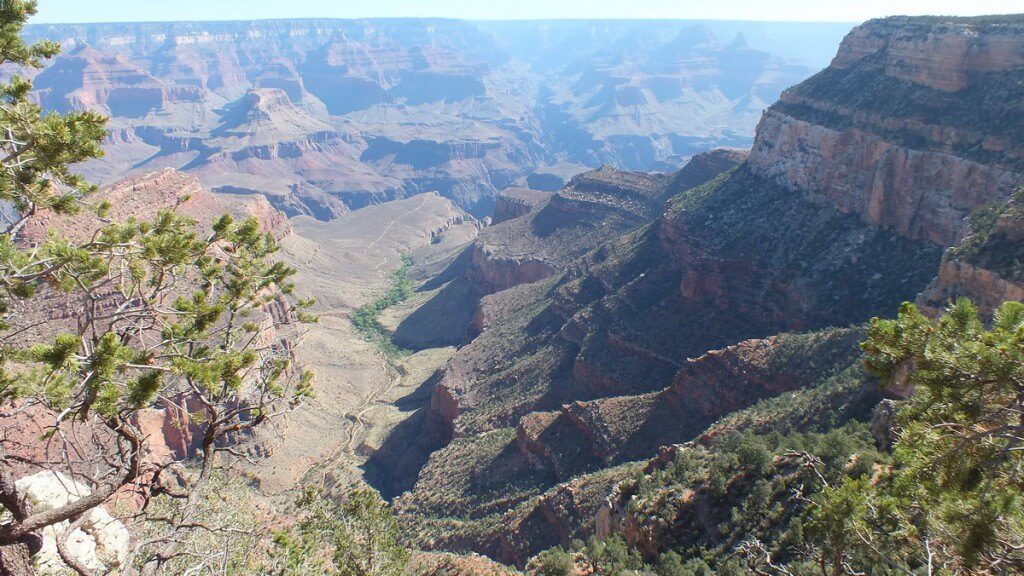

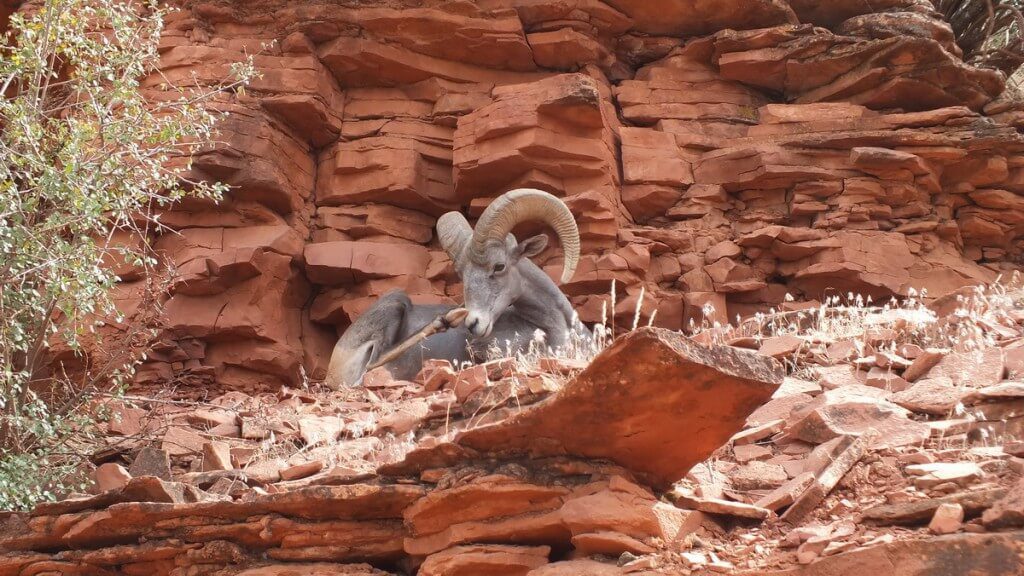
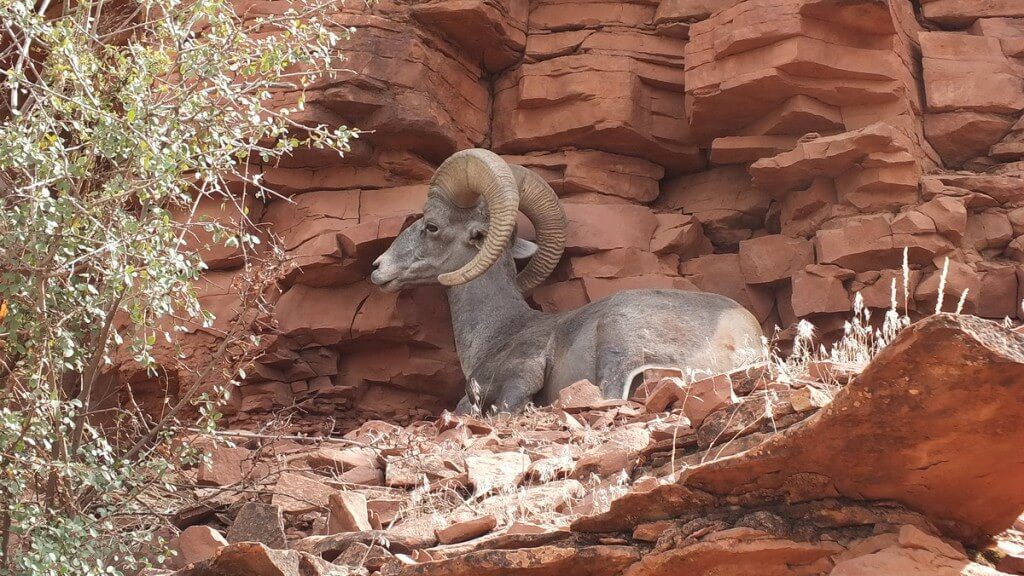
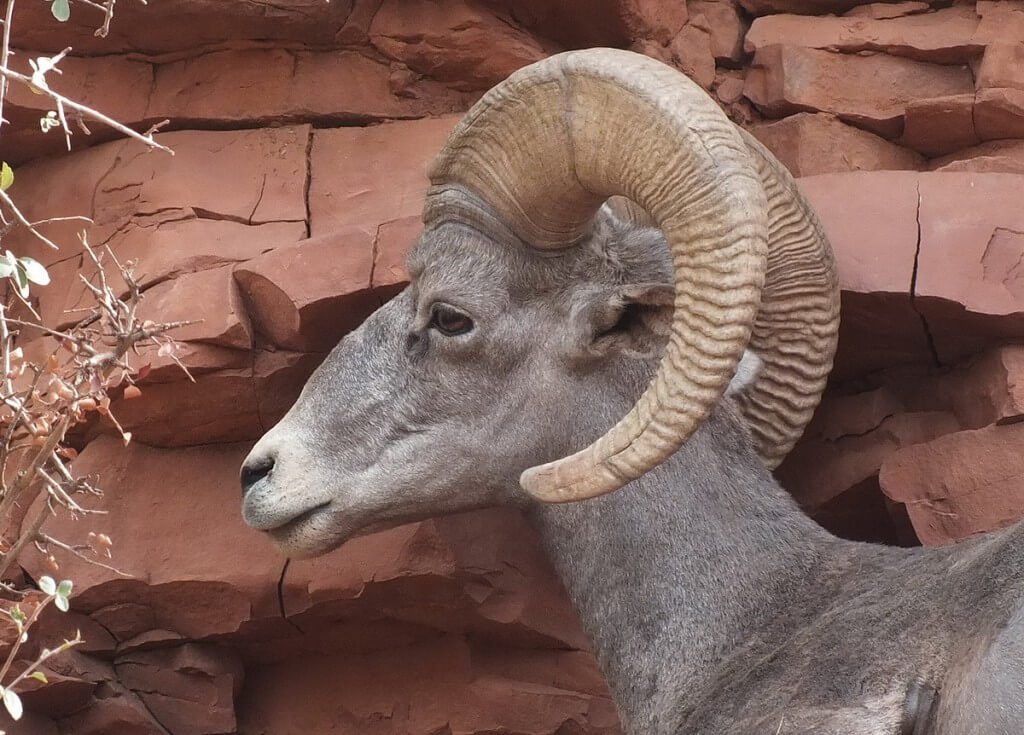
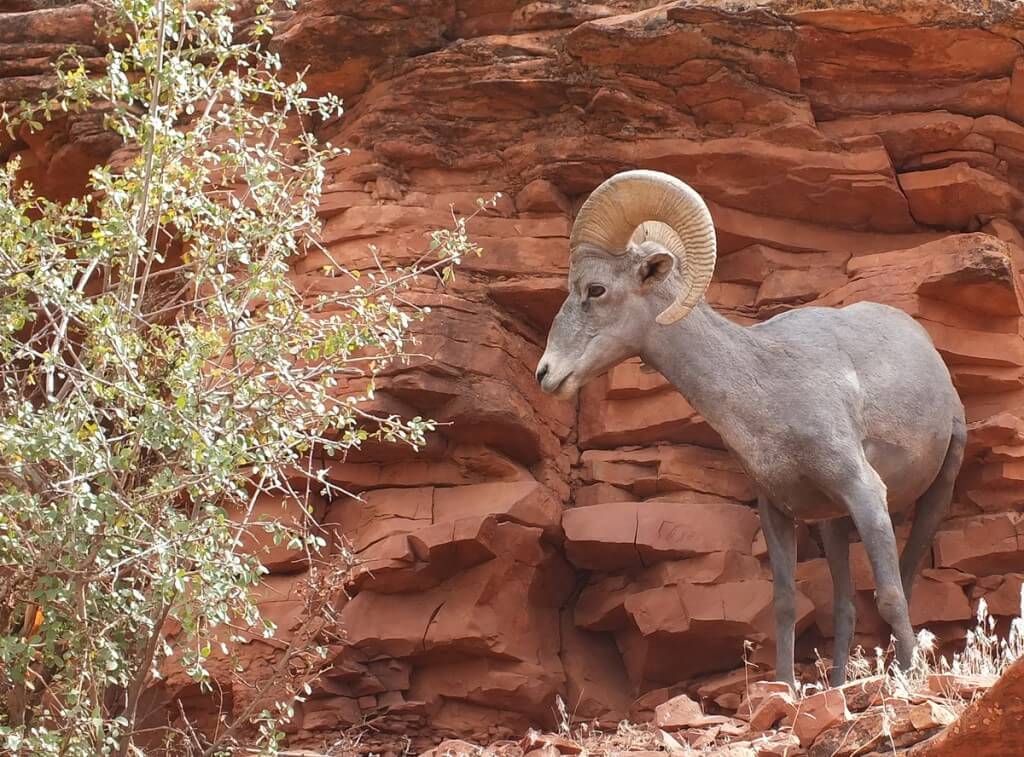
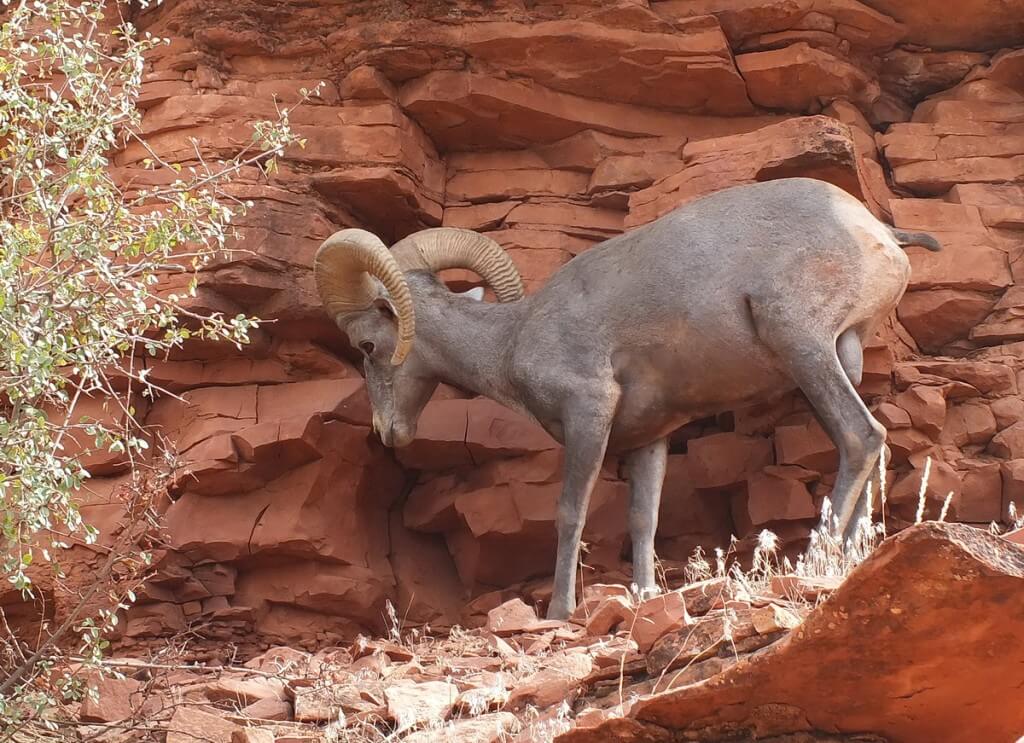
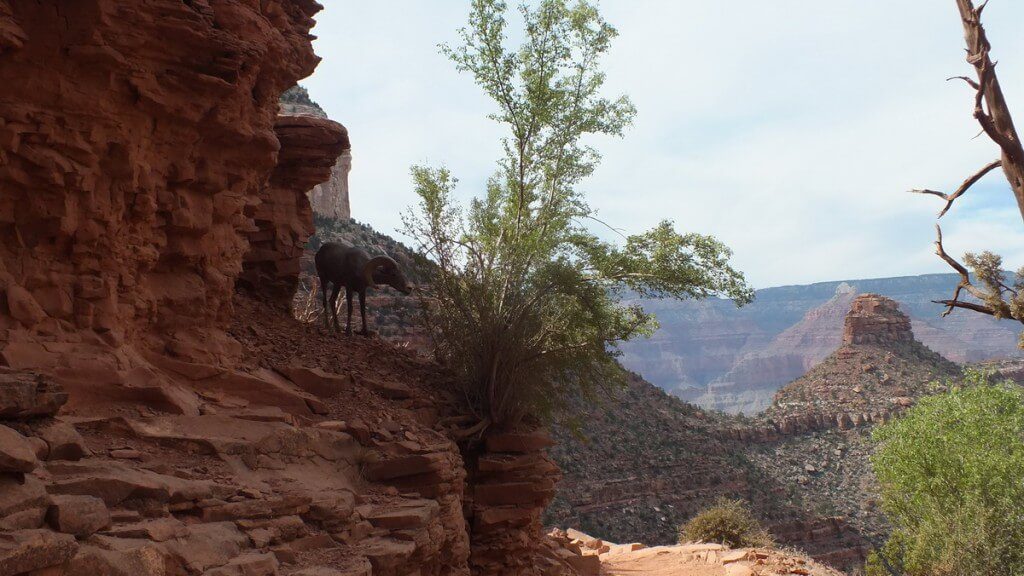


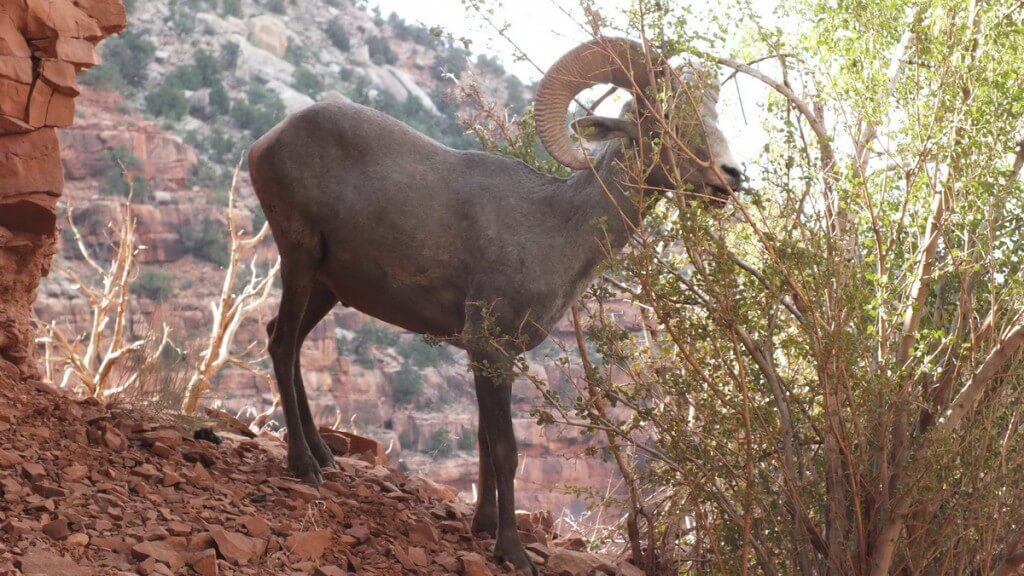
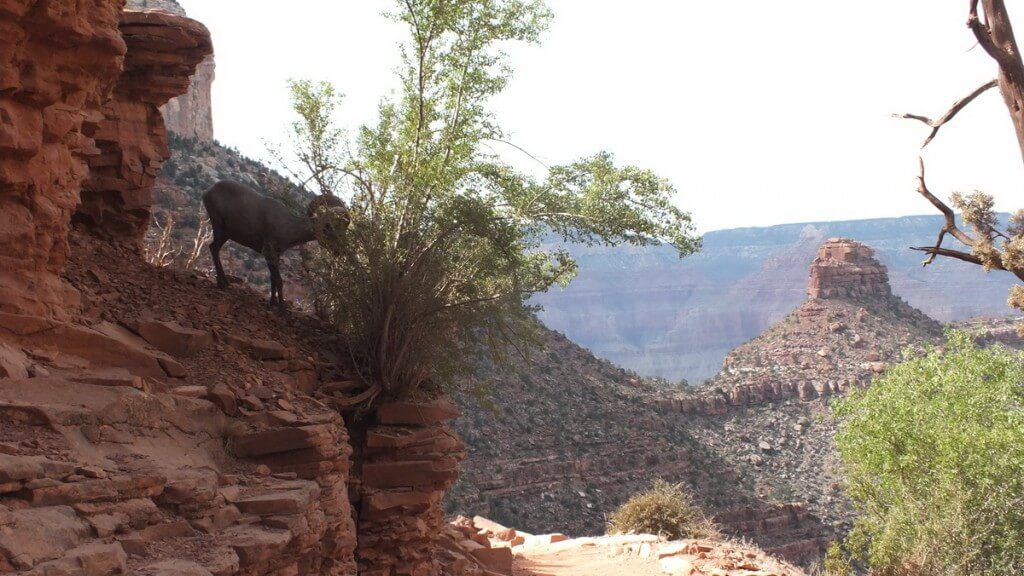
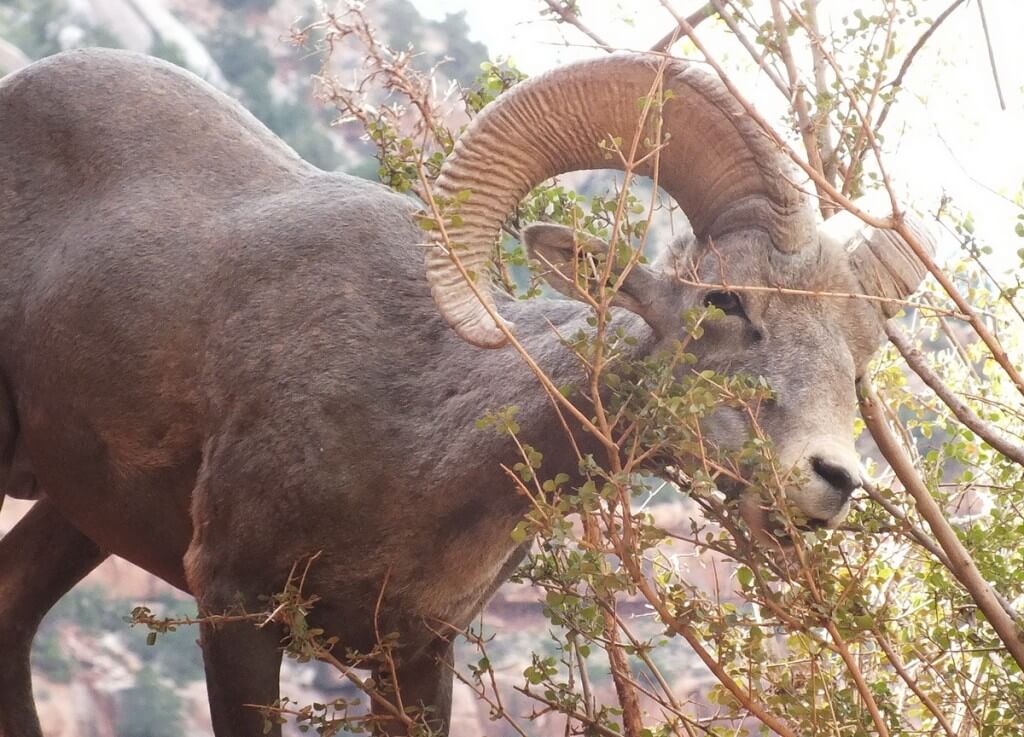
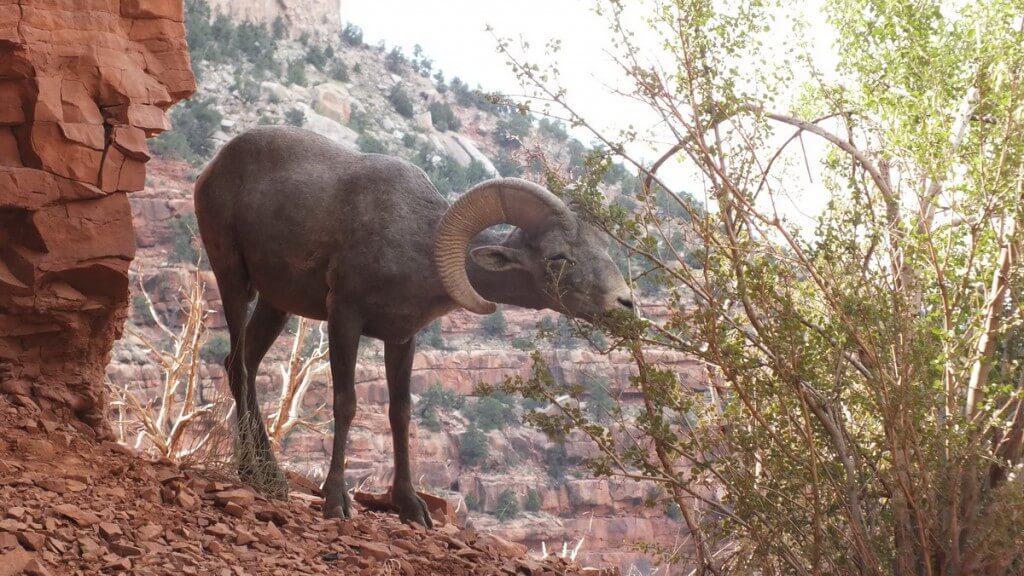
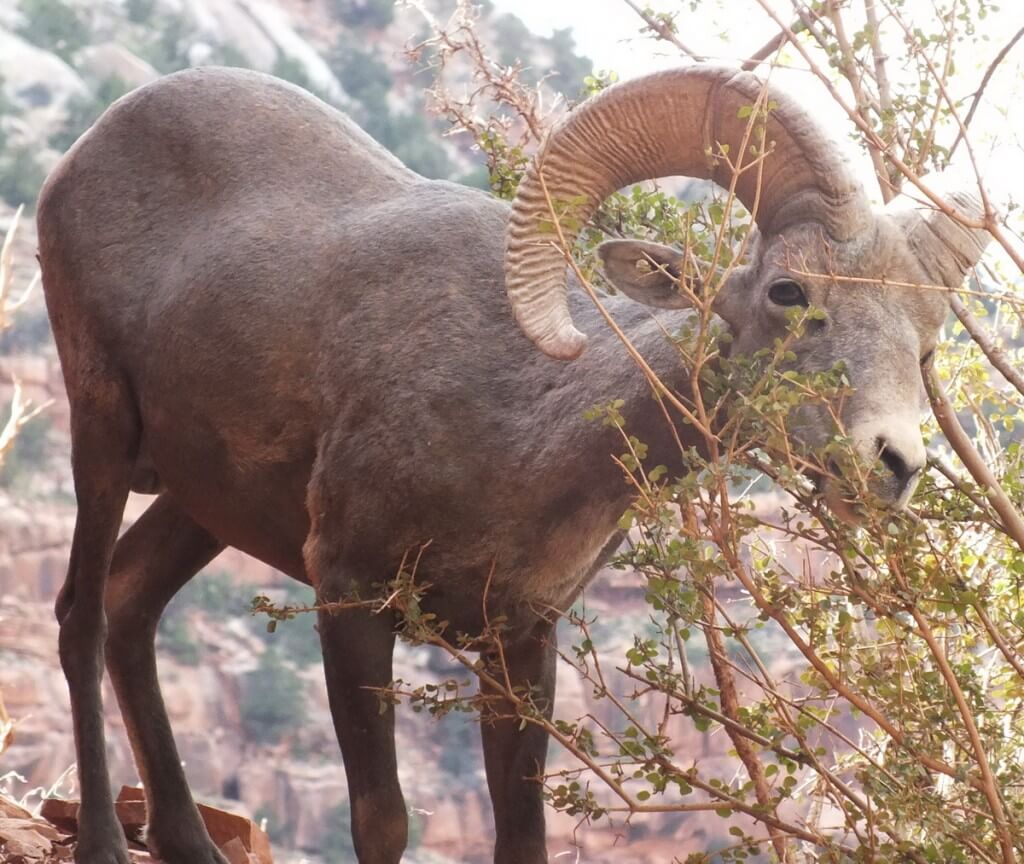
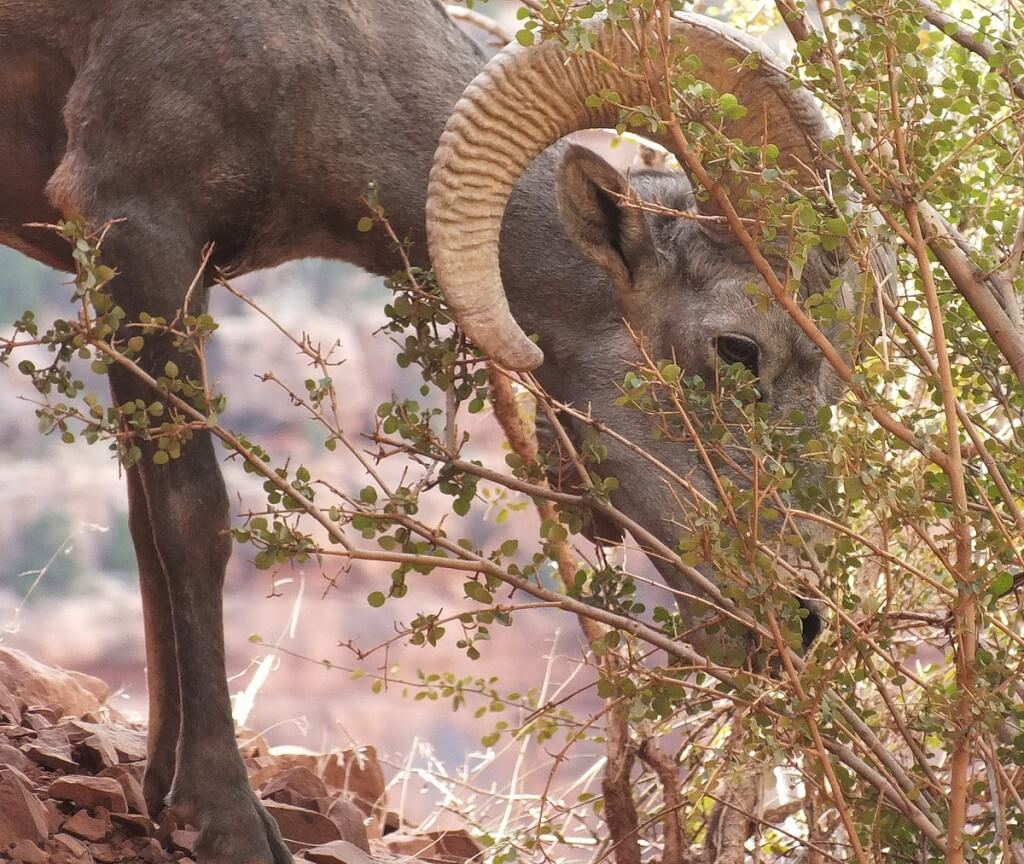
I stumbled across these great pictures today. I had been remembering an encounter that I’d had many years ago on Bright Angel Trail.
I was in my 20’s and accompanying my mother, step-father, and my wife-to-be on her first trip to the Grand Canyon. I had always wished to hike the trail, but no one else felt up to the task. So I grabbed a 1-L bottle of water and started down the trail shortly after sunrise. It was 73 degree F when I started. I was in good shape at the time, so was enjoying the switchbacks and the beauty along the way down. I was hoping to make it to Indian Garden before turning around to hike back up and greet my family for the afternoon.
By ~ 9 am, I had reached the 3-Mile Rest House, refilled my water, and chatted with the ranger there about the burros, daily canyon ‘rescues’, etc. The temperature was quickly climbing to the 90’s, so I realized that the hike back and increasing temps might make for slower ascent, so I turned around to assure I would not be late for my planned return time. Needless to say to you,. the hike back up is tiring. By 10:30, the temperature was over 110 degrees, and I realized that there were groups of us that were walking, then pausing to rest and let our heart-rates return to normal, then continuing on to rest again. So I would tend to leap-frog past the same 2-5 groups of people repeatedly. After a bit, I met a fellow from Croatia, and was given honorary citizenship as a good trail companion. 😉
I was past the 1.5-mile Rest House, soaking the path with my efforts and beginning to HATE switchbacks. I paused and took a drink of water, slowing my breath again. I heard someone call to me and ask if I saw the Big Horn behind me. I turned. There was a Native American man sitting on the uphill side of the trail in jeans and a flannel shirt. He smiled and pointed back down-trail. Sure enough, on the rise shoulder of the trail behind me, there was a beautiful animal standing and looking down at us. I was born an Aries, so the Ram had always had a special significance for me. I stared in appreciation for a moment or two in surprised pleasure.
Oddly, when turned back to comment to the man that had pointed the ram out, he was gone … POOF … gone. I had not heard him rise, or steps receding as he left. Just gone. I blinked and turned back to look at the ram and it too was gone. As you know, many of the places in the switchbacks, you can see people hiking above you and below you as well. I waited to see if I spotted the man for a few minutes and never caught another glimpse. I had seen Big Horns in documentaries, so I was less surprised that it might have leapt away out of sight. As you so aptly described above, they are well camouflaged and agile. The temp was 112 degrees. I am a trained biologist that was preparing to enter medical school. so I was all too familiar with symptoms of heat stroke (basis of the conversation with the ranger earlier). But I had been pretty careful to keep hydrated and had taken a gentle pace on the way back out.
When I reached the trailhead, I met my folks and my bride-to-be and told them out my experience. My wife and I had once seen the movie Thunderheart, and I laughed about a scene I had remembered where Graham Greene (Dances with Wolves, etc.) gave Val Kilmer a hard time about a “white, instant-Indian” having himself a vision, something that Crow Horse told him many natives hoped to experience.
It has always been a fun ‘magical’ memory for me. When someone sent a text today with a Big Horn, I remembered once again and realized that I had never checked to see if there WERE Big Horn sheep in the Canyon, or if the entire thing had been a heat/fatigue inspired hallucination. It was wonderful not only to find your pictures on the trail, but the video as well. Let me know if a Native American in a flannel shirt was the one who clued you in! 🙂
Thank you so much for sharing your own experience with us. It is a delightful read and inspires a sense of awe and wonder. I’m sad to say that no, we did not see a Native American in a flannel shirt. I wish it had been so. It was a fellow trekker that mentioned the Bighorn Sheep that we had so obliviously walked by. But I would never give up on the belief that you encountered a “white, instant-Indian”. Thanks for checking out our blog and sending such a wonderful comment.